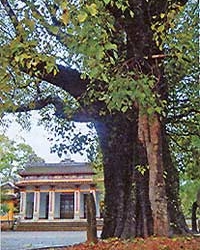400 million years ago, there were no trees on Earth as woody plants only emerged 390 million years ago in Cairo (New York, USA).
From the tallest plant in Asia, recently discovered in China (a 102-meter tall cypress), to the largest rainforest on the planet, the Amazon, or ancient forests that seem to date back to very distant times… they all share one thing in common with every other species or ecosystem: they have a birth date. In fact, although plants first appeared on land about 470 million years ago, trees and forests did not emerge until nearly 390 million years ago.
Chris Berry, a paleobotanist at Cardiff University in the UK, stated that during this period, plants gradually developed the genetic precursors necessary to create trees, which then proliferated into a variety of other plant species.

Woody forest in Cairo (New York).
In 2019, Berry and colleagues reported on the oldest forest recorded in the journal Contemporary Biology. This forest, discovered in Cairo (New York, USA), revealed that the distinctive features of trees and forests—namely wood, roots, and leaves among a population of dozens of plant species—appeared “much earlier than previously thought.” Researchers stated that the birth date of this forest was at the beginning of the Devonian period, 385 million years ago.
Berry indicated that the site in Cairo preserved the fossilized root system of ancient trees, accurately determining where they “came into existence.”
Why do trees have roots?
According to a previous report from Binghamton University in New York, that fossil “map” includes Archaeopteris, an ancient plant species characterized by “large woody roots and leafy branches,” similar to modern trees. In that report, the earliest discovery of Archaeopteris dates back to about 365 million years ago.
Berry stated that the development of these primordial forests depended on the evolution of precursors to establish tree characteristics. The British paleobotanist commented: “I think the triggering factor was the evolution that allowed plants to have a more complex branching system at the base (precursors to roots).” Berry explained that such structures appeared when plants had developed a “genetic toolkit” to build structures resembling today’s trees.
For instance, according to two reports from the Brooklyn Botanic Garden, the initial branching systems at the base developed as early as the Silurian period, around 443.8 million to 419.2 million years ago (before the Devonian), while the first roots appeared at the beginning of the Devonian. Trees with root systems offered significant advantages, primarily their ability to compete for height to absorb sunlight. Therefore, according to natural selection, they passed this beneficial trait to future generations.
Why do trees have broad leaves?
However, certain environmental changes may have created at least one crucial characteristic of trees. According to a 2001 study published in the journal Nature, which PBS featured in the 2021 episode of Eons, megaphylls are a type of leaf common today, characterized by branched veins at the base. They can grow much larger than earlier leaves, thereby absorbing more sunlight. They first appeared around 390 million years ago but started small and only became prevalent after 30 million years, towards the end of the Devonian period.
The study indicated that this 30 million-year delay occurred due to high carbon dioxide (CO2) levels making Earth too hot for large megaphyll leaves. Simply put, they would absorb too much sunlight and become overheated. However, the significant reduction in CO2 levels during the Devonian benefited megaphylls. The drop in greenhouse gas levels cooled the planet, while large megaphylls could adapt with more stomata to absorb the declining CO2 at higher rates. Such leaves could then help propel the revolution of plant forests.
Why do trees have wood?
Tom Kimmerer, a forest scientist from Kentucky, noted that a tree is simply a solution to a problem, and that problem is access to light.
The first plants on land were herbaceous plants—soft, non-woody plants and grasses that typically grew low to the ground. But as soon as a tree grew taller than the others, competition for sunlight began.
Kimmerer remarked: “The characteristic of a perennial plant is to keep its leaves higher than those of other plants to catch sunlight; this is crucial for a tree to function effectively.”
For instance, trees have thick trunks to support the weight above and help them reach higher, thus capturing more sunlight. Trees also have an efficient water transport system to draw water up and bring nutrients back, thanks to xylem and phloem, the tissues that form the tree’s rings. Trees also have extensive root systems that effectively supply all the water to the system.
Herbaceous plants also possess many similar features: they have stems to support their weight, xylem and phloem to transport water and nutrients, and root systems. These features do not necessarily have to function at the intensity required of a tree several meters tall. The only difference is that herbaceous plants are not made of wood, and wood makes the distinction.
Kimmerer concluded: “Wood is one of the greatest structures in the world because it is an adaptation that simultaneously addresses multiple issues. Wood achieves three entirely essential things for a tree: it is sturdy and flexible enough to help the tree grow tall; it is excellent for transporting water over long distances, and it is also very good at storing nutrients. Without wood, trees would bend under their own weight and struggle to transport water and nutrients within their bodies.”





















































